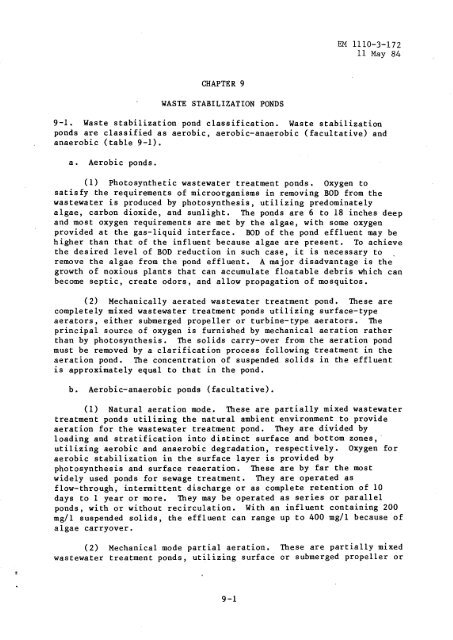Domestic Wastewater Treatment Mobilization Construction - AskTOP
Domestic Wastewater Treatment Mobilization Construction - AskTOP
Domestic Wastewater Treatment Mobilization Construction - AskTOP
You also want an ePaper? Increase the reach of your titles
YUMPU automatically turns print PDFs into web optimized ePapers that Google loves.
EM 1110-3-17211 May 849-1 . Waste stabilization pond classification . Waste stabilizationponds are classified as aerobic, aerobic-anaerobic (facultative) andanaerobic (table 9-1) .a . Aerobic ponds .CHAPTER 9WASTE STABILIZATION PONDS(1) Photosynthetic wastewater treatment ponds . Oxygen tosatisfy the requirements of microorganisms in removing BOD from thewastewater is produced by photosynthesis, utilizing predominatelyalgae, carbon dioxide, and sunlight . The ponds are 6 to 18 inches deepand most oxygen requirements are met by the algae, with some oxygenprovided at the gas-liquid interface . BOD of the pond effluent may behigher than that of the influent because algae are present . To achievethe desired level of BOD reduction in such case, it is necessary toremove the algae from the pond effluent . A major disadvantage is thegrowth of noxious plants that can accumulate floatable debris which canbecome septic, create odors, and allow propagation of mosquitos .(2) Mechanically aerated wastewater treatment pond . These arecompletely mixed wastewater treatment ponds utilizing surface-typeaerators, either submerged propeller or turbine-type aerators . Theprincipal source of oxygen is furnished by mechanical aeration ratherthan by photosynthesis . The solids carry-over from the aeration pondmust be removed by a clarification process following treatment in theaeration pond . The concentration of suspended solids in the effluentis approximately equal to that in the pond .b . Aerobic-anaerobic ponds (facultative) .(1) Natural aeration mode . These are partially mixed wastewatertreatment ponds utilizing the natural ambient environment to provideaeration for the wastewater treatment pond . They are divided byloading and stratification into distinct surface and bottom zones,'utilizing aerobic and anaerobic degradation, respectively . Oxygen foraerobic stabilization in the surface layer is provided byphotosynthesis and surface reaeration . These are by far the mostwidely used ponds for sewage treatment . They are operated asflow-through, intermittent discharge or as complete retention of 10days to 1 year or more . They may be operated as series or parallelponds, with or without recirculation . With an influent containing 200mg/1 suspended solids, the effluent can range up to 400 mg/l because ofalgae carryover .(2) Mechanical mode partial aeration . These are partially mixedwastewater treatment ponds, utilizing surface or submerged propeller or
















